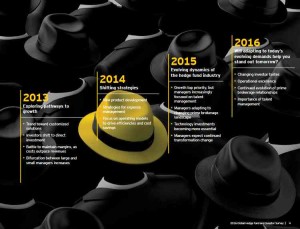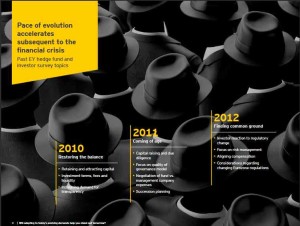Shrinking returns and escalating investor demands. Downward pressure on fees and unrelenting requirements to have robust operating models. This year, competing forces came together to culminate in the perfect storm. In a year marked by lackluster performance and rising investor expectations, one inevitably asks: Will the challenges of today pave the way to a more successful tomorrow? That all depends on how you respond. As we look back on the year that has passed and look ahead to 2017, a few points come into sharp focus.
Differentiation has become the touchstone of the future, and those funds that strategically embrace change for the right reasons and modify their business model in a way that responds to investor demands will be the ones that prosper going forward. Today, the pace of change is accelerating, and the magnitude of its impact and relevance are amplifying. As external pressures and competition for capital mount, he directive for managers has never been clearer: adapt or be left behind.
Key observations
The voice of the investor. 2016 has revealed an unprecedented change in the appetite of investors. More so than ever, investors have achieved a level of sophistication that is challenging managers to more thoroughly explain how their offering achieves specific objectives within investors’ overall portfolios. Almost half of investors are continuing to actively seek out non-traditional products, and when it comes to investing in hedge funds, their choice is segregated accounts that generally allow for customization that more closely align with their specific needs. In addition, investors are demanding more and paying less. Many investors who have utilized low cost, passive investment options or those who have reduced their reliance on money managers altogether and are trading on their own behalf are challenging the fee terms of their funds. And while management fees have continued to come down across funds of all sizes, investors are not materially any more satisfied with the fees they are paying relative to past years. Pressure on fees is not likely to let up, which begs the question: How do fund managers achieve scale to maintain profitability?
Differing priorities for different size managers. Although growth continues to be a priority for funds of all sizes, the smallest managers in particular view growth as an imperative to offset lost fee revenues, as well as mounting expenditures necessary to run the business. The largest managers are most able to weather industry volatility and uncertainty; having largely achieved their growth targets, they increasingly focus on properly supporting their business from an infrastructure and operating model perspective. Meanwhile, midsize managers are placing their bets on talent management, recognizing that their growth agenda and ability to compete with the largest managers can be served by attracting and developing the best and brightest talent.
The path to growth is changing. With asset flows stagnating and investors changing the way they invest, managers are facing the imperative to differentiate not only from one another, but from the growing number of alternative products that are available. We found that in this challenging fundraising environment, managers, particularly mid-size and smaller, are emphasizing existing products rather than developing new ones. Amidst a crowded playing field, innovation and responsiveness to customer needs are imperative to standing out. Next generational data analysis is just one example of the methods that certain managers are deploying to enhance their investment strategy and appeal to investors. Additionally, those managers who identify and thoughtfully target the needs of specific client segments are finding themselves best aligned for success.
Large managers are out in front. The over $10b AUM managers have the upper hand in today’s landscape for a variety of reasons. They have been most successful at raising capital, and have also been more responsive to changing investor demands – offering both the customization and non-traditional hedge fund products investors are looking for, along with the marketing, messaging and operational infrastructure that caters to evolving investor tastes. Investor desire to co-develop specific vehicles – those that provide the investor everything from unique fees to individual transparency and portfolio exposures – falls squarely in the sweet spot of the largest managers. While just 40% offered funds with customized fees and terms in 2015, 2016 has seen that spike to 63%. Similarly, while only 25% offered funds with customized portfolio exposures in 2015, that has now risen to 41%. In addition, the largest managers have sufficient size and scale to support a broader array of products, and as they add non-traditional products to their offerings, smaller managers that cannot support such launches are retrenching – adding more fuel to the allocation trend toward the largest managers.
The operational imperative. As top-line fee pressures intensify and the costs to run an evolved business model increase, the quest for profitability grows even more challenging. New products and customization being driven by investor preferences, while generally being lower fee generating, only add to operational complexities. And investors have clearly communicated that they will not compromise in their expectations that managers have robust infrastructures to support their business. However, investors are also vocal about their desire to not bear the costs of such enhancements. Inevitably, managers are responding by aggressively refining their infrastructure to eliminate redundancies and excessive costs as well as cutting management fees. Investments in technology, including robotics, are leading to improved automation, and cost reductions across big-ticket support functions in the middle and back office are contributing to declining operating expense ratios, which most managers believe have hit bottom. Conversely, nearly half of investors feel there is still more room to cut. Outsourcing is another way that managers will achieve further operational efficiencies and cost reduction, although there is still a major divide between the high comfort level that investors feel toward outsourcing compared to managers’ reluctance to relinquish control.
The changing prime brokerage industry. In last year’s survey, we saw the evolving dynamics of the prime brokerage industry take center stage, and this year is no exception. As banks face continued scrutiny and regulatory pressure, managers and their counterparties continue to grapple with the focus on optimization, funding, balance sheet and liquidity. As a result, many managers have fundamentally changed their prime brokerage relationships, entered into new ones, and increased the number of counterparties they do business with. A majority of managers say that their prime brokers have requested significant alterations to their relationship to keep it economically viable, including increased trade allocations, treasury optimization and platform changes. As a result, relationship monitoring and supervision has become more complex, and governance around relationship management has become more imperative than ever – with a need for formalized structures to drive consistent strategy and oversight of the process.
The war for talent. Talent management rose to the top of hedge fund managers’ and investors’ priorities this year as the war for talent has taken on additional complexities. Not only are funds battling each other for tomorrow’s star players, they now find themselves in heated competition with Internet giants and tech firms, as well as venture capital and start-up companies across all industries. Managers need to demonstrate to investors that they understand the changing talent market and have implemented programs that will help them secure and retain the talent that will drive their business forward. As borne out in this year’s survey findings, talent management now plays a critical role in the competition for institutional assets, with 75% of investors indicating it is a key element in their due diligence process. The focus on talent is sure to continue evolving, as a divide exists between what managers consider paramount versus what future generations of employees believe is critical to attracting them to employers.
Looking forward. As the industry embarks on this next phase in its life cycle, it is clearly fraught with challenges for both managers and investors. The ground rules have changed, and acceptance and adaptation to this dynamic environment are the keys to survival. Changing investor demands are driving a myriad of changes and those firms that listen, understand and strategically embrace change are the firms that will be best positioned to weather the storm. Will adapting to today’s evolving demands help you stand out tomorrow?
At EY, we remain enthusiastic about the future of the global hedge fund industry and look forward to continuing to invest in and support its efforts to enhance financial well-being for investors worldwide.
More in the E&Y Report: Will adapting to today’s evolving demands help you stand out tomorrow?



